Yoga liability waiver forms are used by studios or coaching centers offering yogic classes. These forms are designed to offer protection to yoga instructors and fitness coaches. It so happens that, often in the event of an injury, students and their guardians tend to blame the yoga instructors. With the help of a yoga liability waiver form, yoga teachers can prevent this from ever happening.
When new students join a yogic class, they are required to sign the sign the waiver form before attending their first class itself. A typical yoga liability waiver consists of the name and birth details of a student. Next, the waiver has a section consisting of terms and conditions acquitting yoga teachers of any charges, in case the student suffers an injury. On after consenting to this section are the children admitted into the classes. The student, as well as the yoga teachers, should keep a copy of the waiver as a proof of their records.
Contents
The Components of A Yoga Liability Waiver Form
A typical yoga liability waiver consists of three sections. These include:
- The Details of The Child – The first part of the liability waiver asks for the complete details of the student. These range from the name, age, address, gender to the emergency contact name and number and the medical conditions (if any) that the child might be facing.
The section also helps in determining whether the person joining the class is a minor or not. It is also helpful for parents to list out all the allergies which the child possess or any special needs which the child needs to be tended to.
- The Release of Liability – The release of liability can be called as a list of terms and conditions. Students and the guardians need to comply with these conditions and after complying with the terms are they allowed to attend the classes.
These conditions make the child and the parents aware of all the strenuous activities involved in the classes. The form makes the parents aware that the coaches are not liable in the event of any injury. Nor are they required to provide any form of medical support. However, they may be allowed to provide first-aid, if needed.
There are few other points mentioned in the form which prevent any heirs or representatives to assert claims against the studio. Lastly, the terms state that the students and their guardians understand the conditions of the form and voluntarily agree to the conditions.
- The Consent of the Guardian – This is the last segment of the form. The section is used in the case that the person joining the classes is a minor. In the case that he/she is a minor, the guardian needs to sign this portion stating that they understand the terms and agree to it.
Normally, these forms also consist of a note which says that yoga studio reserves the right to refuse their services. They also state the use of student-related content for private and public purposes. There is also a clause which says that in the case such student-related material is lost, stolen or damaged, the studios are not liable.
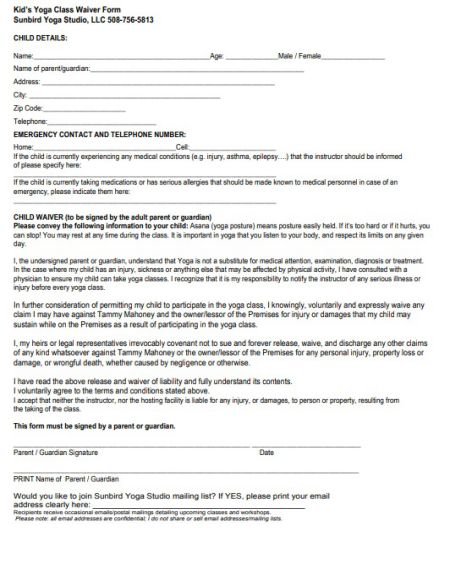
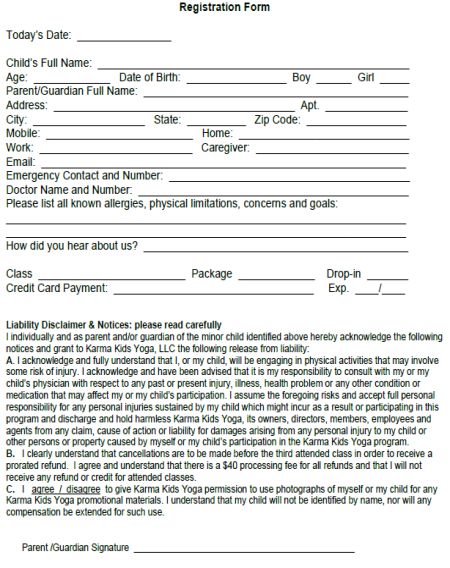
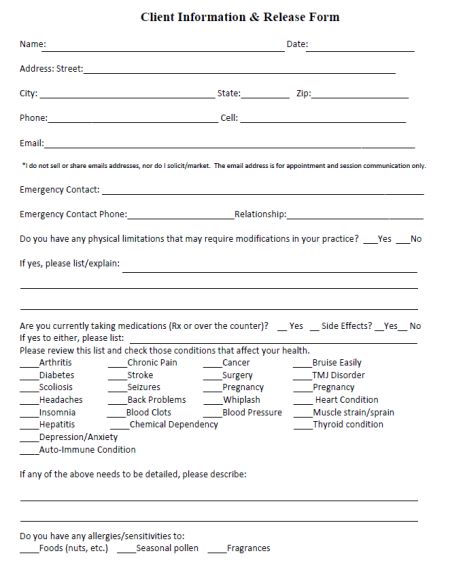
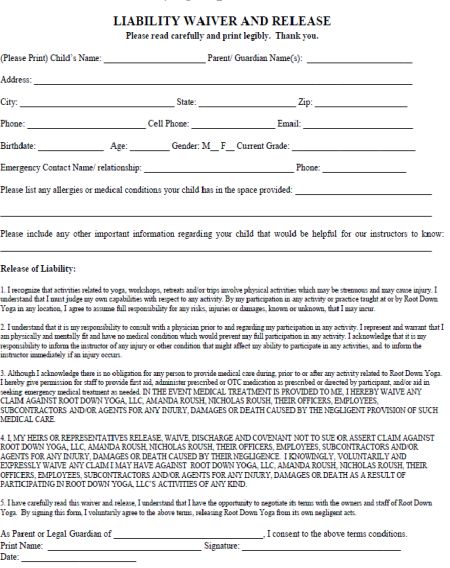
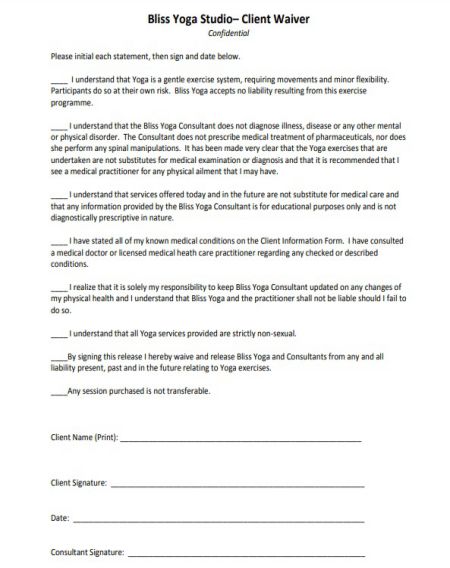
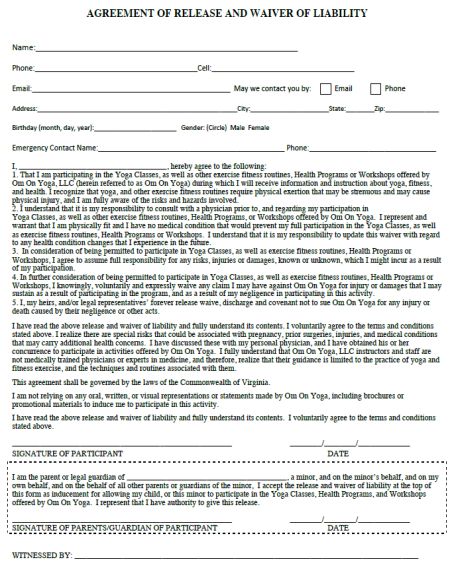
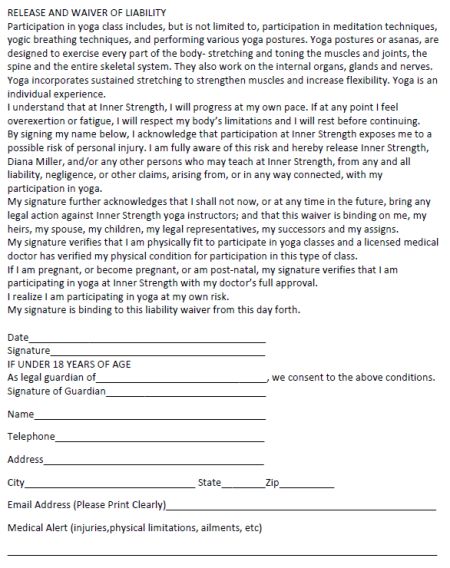
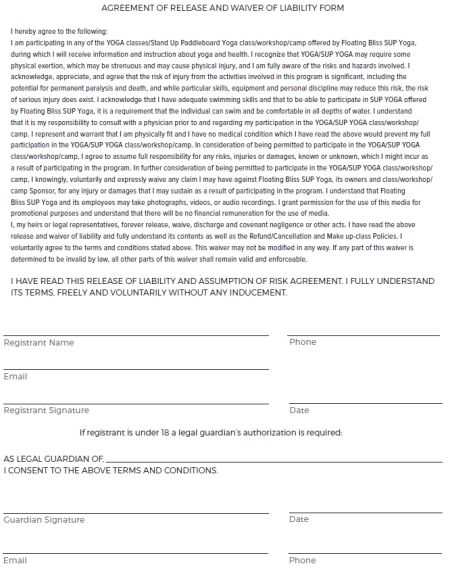
How To Create a Liability Waiver Template for a Yoga Studio
Creating a liability waiver template may sound to be a lot of work, but in reality, it has a fairly easy development process. There are numerous softwares available on the Internet which can easily help you to develop a liability waiver template for a yoga studio within minutes.
Apart from this, these legal waivers developed online are applicable all over the country and can be exported for use in Word or PDF format as well. The waivers contain the complete Release of Liability required for yoga studio coaches to be acquitted of any undue charges that children or guardians may try to pin on them.
Liability Waiver for a Yoga Retreat
Liability waivers are not only for studios. It is necessary for yoga retreats to maintain a liability waiver form as well. There aren’t cases unheard of where a teacher’s retreat to the lap of nature turns into a conflict with students over financial obligations or injury sustained.
In most of the cases, it is the carelessness of the students which causes the drastic injuries. The students on excursion might have just been clicking pictures of themselves without taking account of the dangers.
Things often tend to take a wrong turn such as this. To make sure that such an experience does not turn sour, terms and conditions are carved into stone. These T&C’s outline the obligations of the students as well as the teachers which helps to mutually protect both the students as well as the teachers in the situation of a calamity.
Thus, it results to be quite a simple process but quite unbreakable in the face of wrongdoings.
Usually, a yoga retreat waiver is quite similar to a yoga studio waiver. These can be combined and used one as well. However, using two different waivers, i.e. one for your studio and another for your retreat can prove to be more favorable.
You can use the yoga studio waiver for your studio as well as for the retreat. You must be wondering that if a yoga studio waiver can handle situations for the retreat as well, what is the need for a retreat waiver? Well, the retreat waiver can be highly useful in certain situations which are retreat-specific. As and when needed, you can use them together or separately.
Framing A Children’s Yoga Class Waiver Form
Framing a waiver for a class dedicated to kids is similar to framing any other form of the liability waiver form. The only difference between both the forms is that the one designed for children is written in a much more simplistic manner. This helps the parents to easily go through the form and understand the contents of the terms and conditions.
Such a form starts with the name of the organization or the studio and states that the form is a Yoga Liability Waiver For Children and Teens. It then proceeds on to describe the terms and conditions in a paragraph-wise or a bulleted format.
The terms and conditions implied are same as the ones stated in other waivers, the main point of these serving as a protection for the coaches teaching yoga at these studios.
Next, the form states an affirmation statement and collects details, including:
- Parent’s or Guardian’s Name
- Child’s Name
- Parent’s or Guardian’s Signature
- Child’s Date of Birth
- Gender
- Guardian’s Phone Number
- Guardian’s Email Address
- Any medical conditions about the child which the studio needs to be aware of
- A survey for parents regarding the source of information about the class
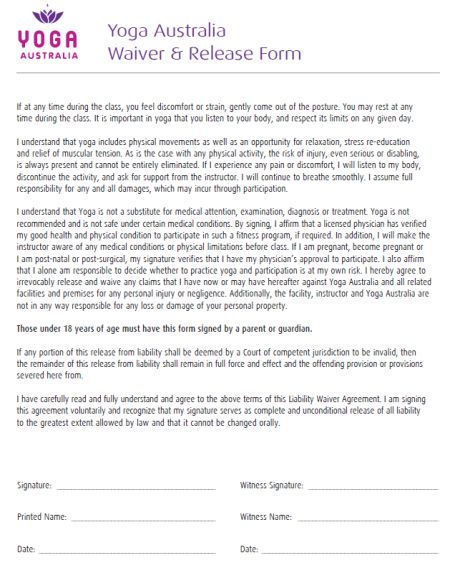
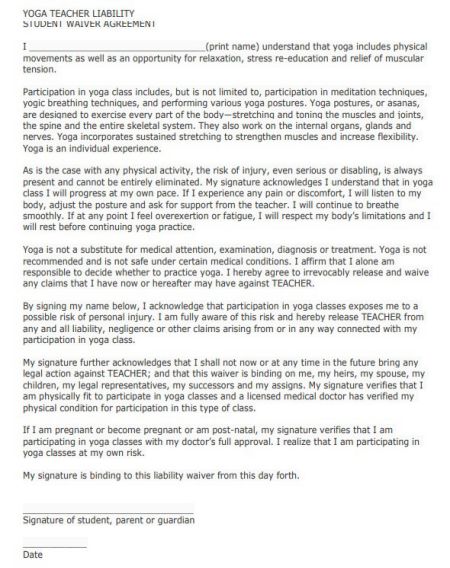
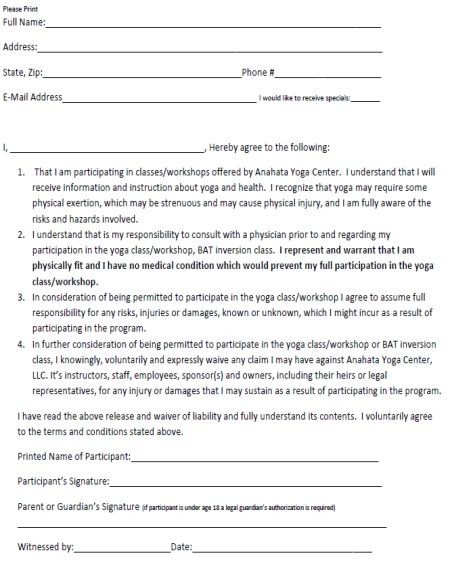
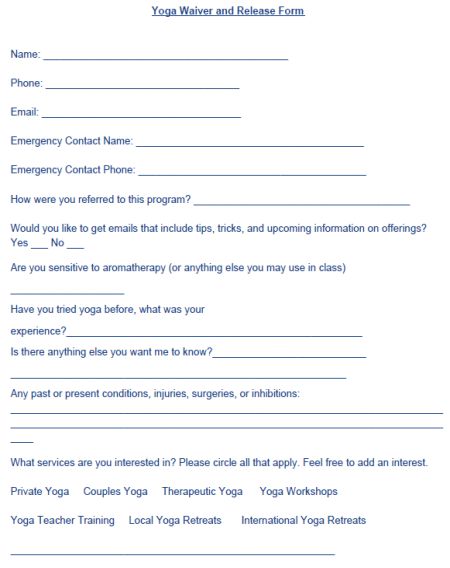
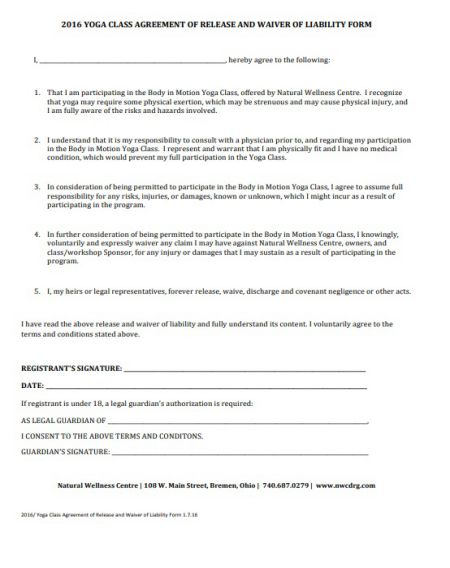
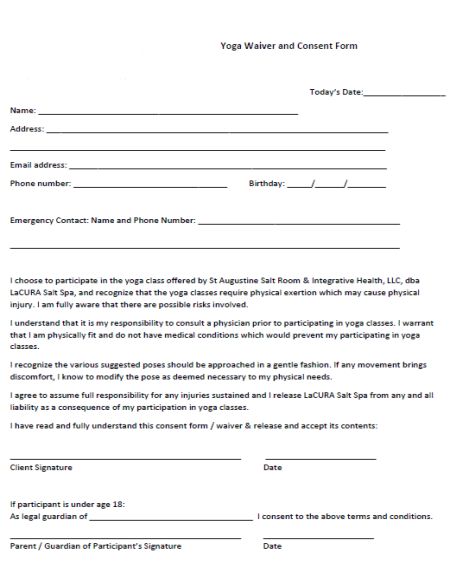
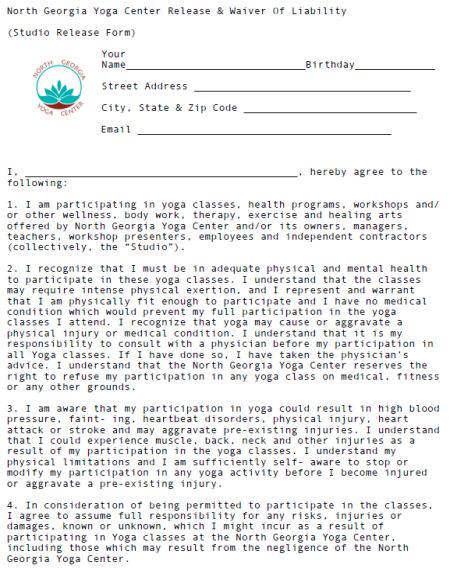
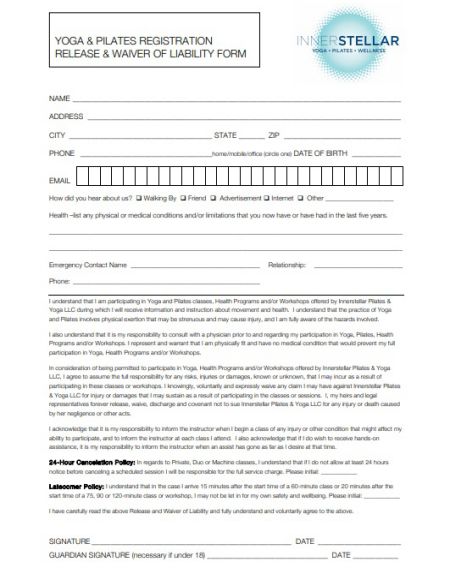
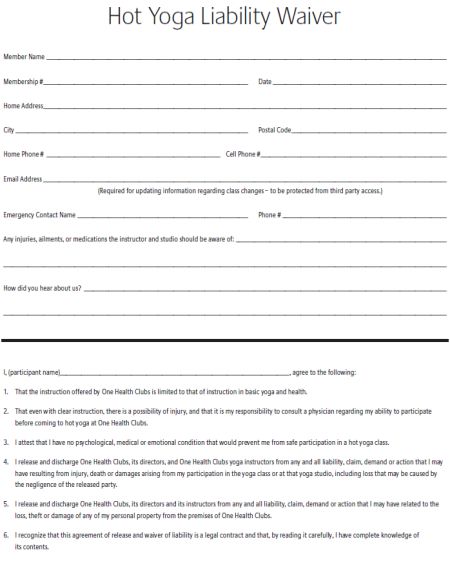
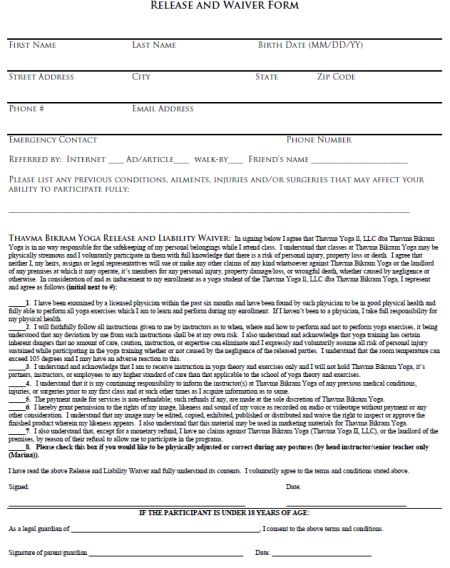
The Legal Essential Components
Yoga is one of the largest growing industries around the world. The increase in its worth also gives rise to the legal risks associated with the industry. To counter this, studio owners need to be more vigilant than ever. They should able to protect themselves from any form of an undue personal injury liability.
A liability waiver form forms to be the first line of defense when it comes to protecting oneself from legal issues. Due to this, you must know the legal essentials while drafting the waiver.
A few of the most important components which should be in the waiver are:
- The Waiver Should Cover Teachers – To protect themselves from potential lawsuits, a lot of studios ask students to sign a waiver before they join. However, what they don’t take into account is the legal protection for the teachers individually. Therefore, it is generally advised that yoga teachers read the waiver and ask it to specifically include legal protection for themselves.
- Know The Language To Make A Strong Waiver – For it to be held properly in court, a waiver should be drafted with the proper nomenclature. The waiver won’t be enforceable in the court of law if the waiver written with just two sentences. To make sure that the form serves as sufficient protection, yoga studios should draft their waiver with close reference with waivers from notable studios.
- Insurance Is A Must – Insurance is particularly important for studio owners. Studio owners should make sure that the insurance covers the forms of yoga as well as any other service that the studio provides. These include services such as teaching, massaging etc. Apart from this, insurance companies have their own lawyers who draft policies that minimize the amount insurance companies have to pay.
- Always Do A Background Screening of Your Students – You should always have complete information about the people who attend your classes. Apart from this, you should also have complete information about the people joining your Teacher Training Programs. To determine if they’re ready or not to enter the program, make use of an intake form and find if they possess the emotional stability to enter the program.
Liability Waiver For a Private Yoga Class
Private yoga classes are requested by people who want complete attention of their teachers. These classes, too, require a waiver to be signed before classes are made open to the students.
Similar to other forms of yoga waivers, private yoga classes their own set of terms and conditions. While most of the sections of the form remain the same, the terms and conditions are a little different than the other waivers.
The release of liability in these waiver state that whenever the student feels discomfort or strain in their body arising from the yogic exercise, they may exit the posture and rest at any given point in the class. Therefore, it is impertinent that they respect the limits of their body.
Secondly, the waiver also states that the students understand that yoga isn’t a substitute for other medical things such as medical attention, examination or treatment. Therefore, it is important that the students consult a physician before taking up yoga as a daily activity. It is also the responsibility of the students to notify the teachers about any pain that they might be suffering from and to not perform exercises which cause additional pain or strain.
Only after consenting to this and providing their signature, are the students allowed to attend the classes.
What Students Should Know Before Signing Their Next Waiver
There are a few aspects which students should understand before signing their next yoga liability waiver. These include:
- The Purpose – A waiver takes control of protecting the business from any undue liability. They contain the risks that may occur and make it clear that the yoga classes are not responsible for them. It also states that in the event that you sustain injuries, it is you who is liable and not any other person. Therefore, it basically ascertains that you cannot sue the classes even if you face an injury.
- A Case for Negligence – However, a legal waiver does not make any yoga class to be completely ironclad. Just a student has to sign a waiver to follow the teachings of the teacher, the yoga class too has a duty to provide a secure environment for learning for the students. If the studio owner breaches this duty and fails to provide a secure environment, the student can sue the studio owner for their negligence.
- Mediation – There may have been some way in which your yoga studio may have hurt you. Maybe it was because the practitioners overlooked some yogic principles and failed to abide by them. However, it goes against your virtues to sue the very studio where you practice. In such cases, you can go for mediation.
Mediation allows people to resolve their disputes in an alternate manner. In such cases, both parties can seek to hear each other out and negotiate a settlement advantageous to both. Using such a path, you can ask to be reimbursed for the medical costs for your treatment.
- Be Advised By A Licensed Attorney – The cases where people are harmed during yogic exercises are really low. However, in the case that students feel that they’ve been wronged with, you should always choose to be advised by a licensed attorney so that he/she can provide the best options for you.
A Sample Yoga Disclaimer
There are a few aspects of a yoga liability waiver which are consistent with most of the waivers. Therefore, these aspects are available on almost every sample yoga disclaimer. The studio can make changes as and where they see fit.
Every sample yoga disclaimer includes:
- Acknowledgments from the students from participants regarding their health
- Possessing requirements such as a doctor’s approval to attend the yogic classes.
- Non-compliance of any warranties which relate to injuries, fitness improvements and continuation of yoga classes.
- Special exclusion in the cases of injury and damages from personal property.
- General exclusion for calamities which are uncontrollable by both parties.
The Yoga Release Form
A yoga release form is similar to the yoga liability waiver form. It contains all the aspects of a liability waiver but has a special section known as the participant release.
According to this section, the student makes it known that by agreeing to the form, the student confirms that he/she has read, understood and thus, agrees to all the points which are mentioned in the binding contract. It also makes it known that by accepting the conditions, the student is eligible to attend the classes and participate in the programs.
If the students do not agree to any of the mentioned points, they are not offered enrollment.
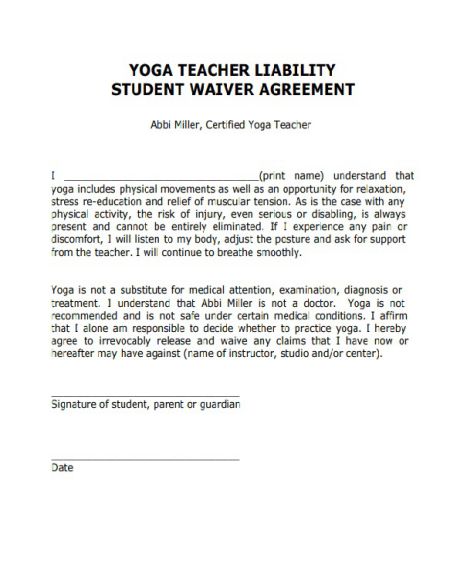
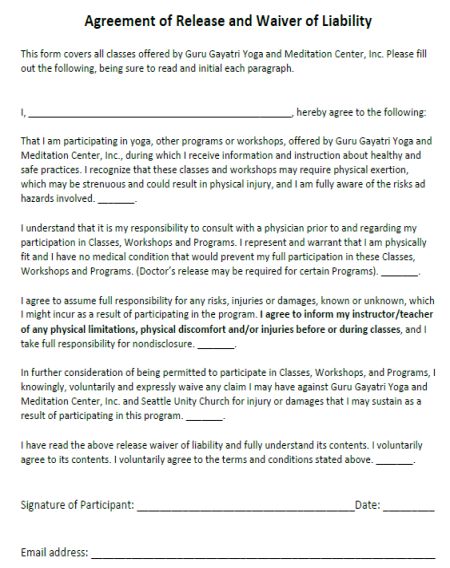
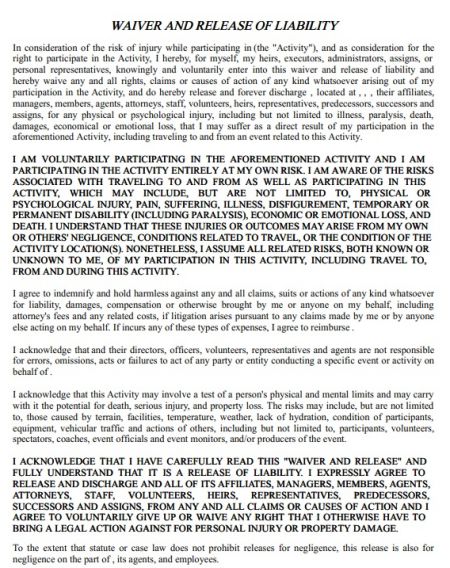
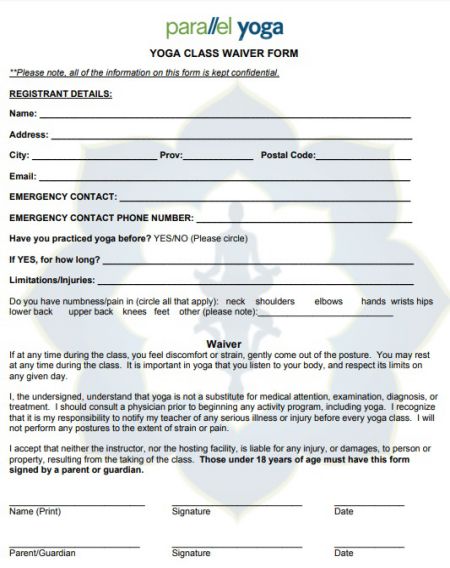
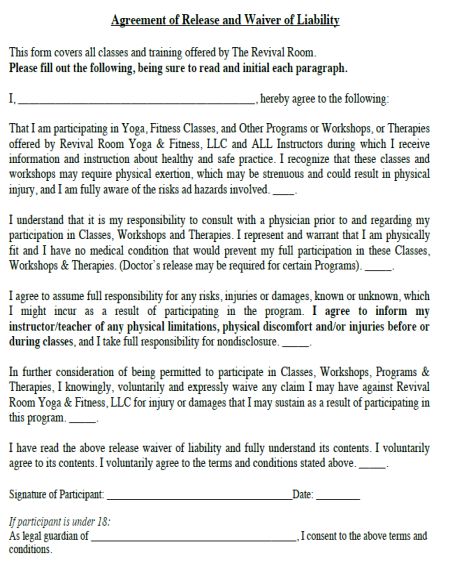
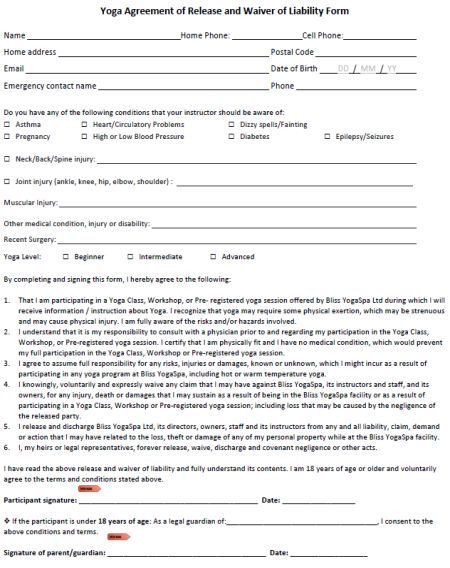
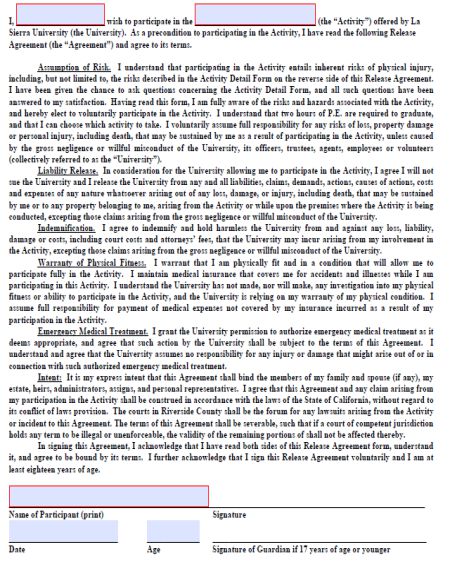
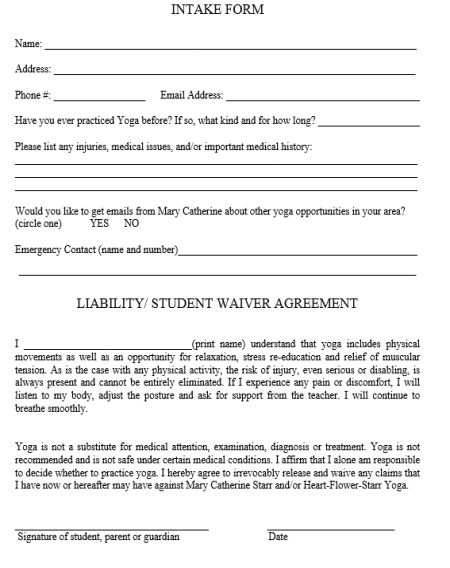
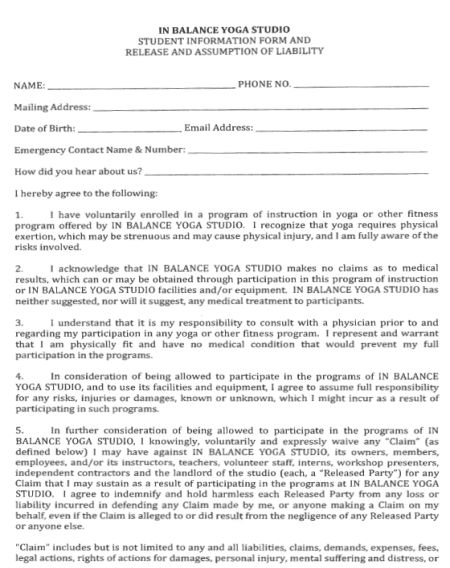
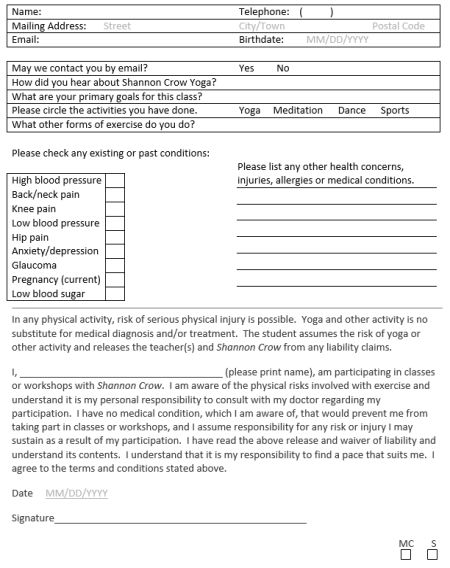
Yoga Class Waiver and It’s Uses
A yoga class waiver helps students as well teacher to establish a clear understanding between them. It makes them known that the teacher, cannot be held accountable for any injury faced by the student.
Signing a waiver, however, does not make the teacher completely immune to any forms of legal cases which may arise from the student. However, it does help in deterring litigation in cases where the student faces an injury.
There are varied uses for a yoga class waivers. These uses range include:
- Making the student aware of the risks which are associated with yoga
- Providing students with an opportunity to consider their health options and if required, get checkups from their doctors.
- Consulting their doctor also helps them in knowing if yoga would be a correct form of exercise for them.
- The waiver forms often hold a lot more amount of data than that provided in other forms of advertisements such as brochures. These waivers hold additional details about the classes which the students would be attending.
- Finally, the waiver helps to form a relationship on the basis of a written contract. This is perhaps, the most important use of a waiver. It helps to give both the student as well as the teacher a clear understanding of how their relationship would be established while keeping in mind the risks involved.